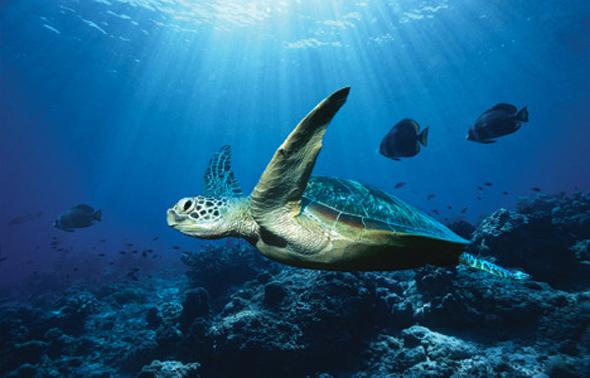“Similarly, God took the incarnation of tortoise, Kurma. There was a churning of the ocean, and the churning rod must be rested on something solid.”
Sri Caitanya-caritamrta, Madhya-lila 20.294-298
by His Divine Grace A. C. Bhaktivedanta Swami Prabhupada
New York, December 19, 1966

Osa Peninsula Chronicles — For centuries, determining longitude was an extremely difficult task for sailors, so difficult that it’s been thought improbable — if not impossible — for animals to do it.
But migratory sea turtles have now proved capable of sensing longitude, using almost imperceptible gradients in Earth’s magnetic field.
“We have known for about six years now that the magnetic map of turtles, at a minimum, allows turtles to detect latitude magnetically,” said biologist Ken Lohmann of the University of North Carolina, who describes the turtle’s power Feb. 24 in Current Biology. “Up until now, that was where the story ended.”
Lohmann specializes in animal navigation, and work from his laboratory and others have exhaustively demonstrated how sea turtles — along with many birds, fish and crustaceans — use gradients in Earth’s magnetic field to steer.
Those differences, however, are far greater by latitude than by longitude. Travel north or south from Earth’s magnetic poles, and their pull weakens noticeably. Travel straight east or west, and the pull doesn’t change. Instead the pull’s angle changes, and only to an infinitesimally slight degree.
That turtles and other migratory animals could detect such a small change was considered unrealistic, but experiments on animals released in out-of-the-way locations repeatedly described them finding home with unerring accuracy and efficiency, explicable only as a product of both longitudinal and latitudinal awareness.
Several nonmagnetic explanations were proposed, foremost among them a “dual clock” mechanism analogous to human methods of calculating longitude, which sailors perform by comparing precise differences between the time locally and at an arbitrary longitudinal line, such as the Greenwich Meridian. No such mechanism has been found, however, and longitudinal differences in local airborne or waterborne chemicals don’t seem to explain animals’ uncanny long-distance steering.
“A skeptic could reasonably believe that the latitudinal cue is magnetic, but that determining east-west position depends on magic,” wrote James L. Gould, a Princeton University evolutionary biologist, in a 2008 Current Biology commentary on animal navigation.
In the new study, researchers led by Lohmann and graduate student Nathan Putnam, also a UNC biologist, placed hatchling loggerhead sea turtles from Florida inside pools of water surrounded by computer-controlled magnetic coil systems.
By varying the currents, Lohmann and Putnam could precisely reproduce the geomagnetic characteristics of two points at identical latitude, but on opposite sides of the Atlantic. Into each pool they placed the hatchlings, which in the wild would instinctively follow a migratory path from their home beach and into the currents that circle the Sargasso Sea and loop around the Atlantic.
In the first pool, programmed to the geomagnetic field in the western Atlantic near Puerto Rico, the turtles swam northeast, on the same trajectory as loggerheads in the wild at that locale. In the other pool, set to the geomagnetics of the eastern Atlantic near the Cape Verde islands, the turtles swam northwest.
No other cues could explain their directions. Against reasonable expectation, the turtles clearly sensed differences in geomagnetic angle.
Gould, who was not involved in the study, wrote an accompanying commentary. Whereas his earlier article was titled “Animal Navigation: The Longitude Problem,” this was called “Animal Navigation: Longitude at Last.” The findings are “the final piece of the puzzle,” he wrote.
Lohmann now plans to study whether currents affect the turtles’ longitudinal compass, and whether the turtles detect differences over short distances. He also suspects that other animals may have a similar longitudinal compass.
“The mechanism we’ve found in turtles might also exist in birds,” he said.
Finally, there is evidence that sea turtle hatchlings imprint chemical cues unique to their natal beach and use this information as adults to return to the same beach for nesting.
Full article







Speak Your Mind